Coronavirus Disease 2019 (COVID-19)
Disclaimer: Information as of December 2022
Source: Department of Health in the Philippines ,World Health Organization & Department of Foreign Affairs
Latest Announcements/Advisory
What is COVID-19?
- COVID-19 is a disease caused by a new strain of coronavirus. ‘CO’ stands for corona, ‘VI’ for virus, and
- ‘D’ for disease. Formerly, this disease was referred to as ‘2019 novel coronavirus’ or ‘2019-nCoV.’ The COVID-19 virus is a new virus linked to the same family of viruses as Severe Acute Respiratory Syndrome (SARS) and some types of common cold.
What are the symptoms of COVID-19?
- Symptoms can include fever, cough, and shortness of breath. In more severe cases, infection can cause pneumonia or breathing difficulties. More rarely, the disease can be fatal. These symptoms are similar to the flu (influenza) or the common cold, which are a lot more common than COVID-19. This is why testing is required to confirm if someone has COVID-19.
How does COVID-19 spread?
- The virus is transmitted through direct contact with respiratory droplets of an infected person (generated through coughing and sneezing). Individuals can also be infected from and touching surfaces contaminated with the virus and touching their face (e.g., eyes, nose, mouth). The COVID-19 virus may survive on surfaces for several hours, but simple disinfectants can kill it.
Who is most at risk?
- We are learning more about how COVID-19 affects people every day. Older people, and people with chronic medical conditions, such as diabetes and heart disease, appear to be more at risk of developing severe symptoms. As this is a new virus, we are still learning about how it affects children. We know it is possible for people of any age to be infected with the virus, but so far there are relatively few cases of COVID-19 reported among children. This is a new virus and we need to learn more about how it affects children. The virus can be fatal in rare cases, so far mainly among older people with pre-existing medical conditions.
What is the treatment for COVID-19?
- There is no currently available vaccine for COVID-19. However, many of the symptoms can be treated and getting early care from a healthcare provider can make the disease less dangerous. There are several clinical trials that are being conducted to evaluate potential therapeutics for COVID-19.
How can the spread of COVID-19 be slowed down or prevented?
- As with other respiratory infections like the flu or the common cold, public health measures are critical to slow the spread of illnesses. Public health measures are everyday preventive actions that include:
- staying home when sick;
- covering mouth and nose with flexed elbow or tissue when coughing or sneezing. Dispose of used tissue immediately;
- washing hands often with soap and water; and
- cleaning frequently touched surfaces and objects.
What can we do to prevent the spread of the Virus?
- Practice frequent and proper handwashing – wash hands often with soap and water for at least 20 seconds. Use an alcohol-based hand sanitizer if soap and water are not available.
- Practice proper cough etiquette.
- Cover mouth and nose using handkerchief/tissue (sleeves or crook of the elbow may also be used to cover the mouth when coughing or sneezing).
- Move away from people when coughing.)
- Do not spit.
- Throw away used tissues properly.
- Always wash your hands after sneezing or coughing.
- Use alcohol/sanitizer.
- Maintain distance at least one meter away from individual/s manifesting with flu-like symptoms.
- Avoid unprotected contact with farm or wild animals (alive or dead), animal markets, and products that come from animals (such as uncooked meat).
- Ensure that food is well-cooked.
- Maintain a healthy lifestyle.
History of exposure Include:
- Close contact who took care handled specimens and/or lived with a confirmed case of 2019-nCoV infection; or
- Close contact is defined as:
- Healthcare-associated exposure, including providing direct care for nCoV patients, working with health care workers infected with
novel coronavirus, visiting patients or staying in the same close environment as a nCoV patient
- Working together in close proximity or sharing the same classroom environment with a nCoV patient
- Traveling together with a nCoV patient in any kind of conveyance
o Living in the same household as a nCoV patient
b. visiting/working in a live animal market in China
c. direct contact with animals in China with circulating 2019-nCoV in human and animals
Can the virus that cause COVID-19 be transmitted through the air?
- Studies to date suggest that the virus that causes COVID-19 is mainly transmitted through contact with respiratory droplets rather than through the air.
Can COVID-19 be caught from a person who has no symptoms?
- The main way the disease spreads is through respiratory droplets expelled by someone who is coughing. The risk of catching COVID-19 from someone with no symptoms at all is very low. However, many people with COVID-19 experience only mild symptoms. This is particularly true in the early stages of the disease. It is, therefore, possible to catch COVID-19 from someone who has, for example, just a mild cough and does not feel ill. WHO is assessing ongoing research on the period of transmission of COVID-19 and will continue to share updated findings.
Can I catch COVID-19 from the feces of someone with the disease?
- The risk of catching COVID-19 from the feces of an infected person appears to be low. While initial investigations suggest the virus may be present in feces in some cases, spread through this route is not a main feature of the outbreak. Who is assessing ongoing research on the ways COVID-19 is spread and will continue to share new findings. Because this is a risk, however, it is another reason to clean hands regularly, after using the bathroom and before eating.
What can I do to protect myself and prevent the spread of disease?
Protection measures for everyone
- Stay aware of the latest information on the covid-19 outbreak, available on the who website and through your national and local public health authority. Covid-19 is still affecting most people in china with some outbreaks in other countries. Most people who become infected experience mild illness and recover, but it can be more severe for others. Take care of your health and protect others by doing the following:
- Regularly and thoroughly clean your hands with an alcohol-based hand rub or wash them with soap and water.
- Why? Washing your hands with soap and water or using alcohol-based hand rub kills viruses that may be on your hands.
- Maintain at least 1 meter (3 feet) distance between yourself and anyone who is coughing or sneezing.
- Why? When someone coughs or sneezes they spray small liquid droplets from their nose or mouth which may contain the virus. If you are too close, you can breathe in the droplets, including the covid-19 virus if the person coughing has the disease.
- Avoid touching eyes, nose and mouth
- Why? Hands touch many surfaces and can pick up viruses. Once contaminated, hands can transfer the virus to your eyes, nose or mouth. From there, the virus can enter your body and can make you sick.
- Make sure you, and the people around you, follow good respiratory hygiene. This means covering your mouth and nose with your bent elbow or tissue when you cough or sneeze. Then dispose of the used tissue immediately.
- Why? Droplets spread the virus. By following good respiratory hygiene you protect the people around you from viruses such as cold, flu and covid-19.
- Stay home if you feel unwell. If you have a fever, cough and difficulty breathing, seek medical attention and call in advance. Follow the directions of your local health authority.
- Why? National and local authorities will have the most up to date information on the situation in your area. Calling in advance will allow your health care provider to quickly direct you to the right health facility. This will also protect you and help prevent the spread of viruses and other infections.
- Stay informed on the latest developments about covid-19. Follow the advice given by your healthcare provider, your national and local public health authority or your employer on how to protect yourself and others from covid-19.
- Why? National and local authorities will have the most up to date information on whether covid-19 is spreading in your area. They are best placed to advise on what people in your area should be doing to protect themselves.
- Keep up to date on the latest COVID-19 hotspots (cities or local areas where COVID-19 is spreading widely). If possible, avoid traveling to places – especially if you are an older person or have diabetes, heart or lung disease.
- Why? You have a higher chance of catching COVID-19 in one of these areas
Protection measures for persons who are in or have recently visited (past 14 days) areas where covid-19 is spreading
- Follow the guidance outlined above in (Protection measures for everyone)
- Stay at home if you begin to feel unwell, even with mild symptoms such as headache and a slight runny nose, until you recover.
- Why? Avoiding contact with others and visits to medical facilities will allow these facilities to operate more effectively and help protect you and others from possible covid-19 and other viruses.
- If you develop fever, cough and difficulty breathing, seek medical advice promptly as this may be due to a respiratory infection or other serious condition. Call in advance and tell your provider of any recent travel or contact with travelers.
- Why? Calling in advance will allow your health care provider to quickly direct you to the right health facility. This will also help to prevent the possible spread of covid-19 and other viruses.
How likely am I to catch COVID-19?
- The risk depends on where you are – and more specifically, whether there is a COVID-19 outbreak unfolding there.
- For most people in most locations, the risk of catching COVID-19 is still low. However, there are now places around the world (cities or areas) where the disease is spreading. For people living in, or visiting, these areas the risk of catching COVID-19 is higher. Governments and health authorities are taking vigorous action every time a new case of COVID-19 is identified. Be sure to comply with any local restrictions on travel, movement or large gatherings. Cooperating with disease control efforts will reduce your risk of catching or spreading COVID-19.
- COVID-19 outbreaks can be contained and transmission stopped, as has been shown in China and some other countries. Unfortunately, new outbreaks can emerge rapidly. It’s important to be aware of the situation where you are or intend to go. WHO publishes daily updates on the COVID-19 situation worldwide. You can see these at https://www.who.int/emergencies/diseases/novel-coronavirus-2019/situation-reports/
For Filipinos returning to the Philippines from China, Hong Kong, Macau, and other countries with confirmed cases of COVID-19
- The Department of Health will take care of you if you return home.
- Upon arrival in the Philippines, you will be taken care of in a health facility for monitoring and further management for 14 days.
- If you have fever and/ or cough upon arrival, immediately inform the quarantine medical officers on duty at the airport or seaport.
- Wash hands often with soap and water for at least 20 seconds. Used an alcohol-based hand sanitizer if soap and water are not available.
- Cover your mouth with a tissue or shirt sleeve when coughing and sneezing. Dispose tissue properly.
- Observe social distance from loved ones if you are manifesting flu-like symptoms.
For information about the Coronavirus Disease 2019 (COVID-19), you may click on the following link to learn more;
Government Memorandums
Office of the President
Department of Foreign Affairs
Omnibus Guidelines on Quarantine and Testing of All Returning Filipino
Psychosocial Support Session
For people needing Psychosocial session, you may get in touch with our trained PSS counselor over the phone: +639175328500 or by calling the PRC COVID-19 hotline 1158, from Mondays to Saturdays 24/7 Manila time, for emergencies dial 911 or 143.
This service is provided over the telephone in Filipino/English.
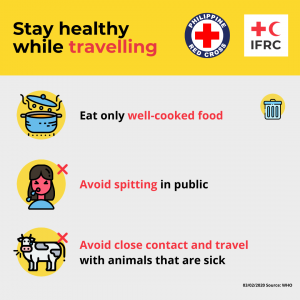
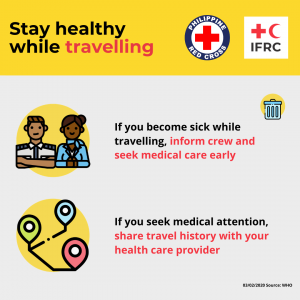
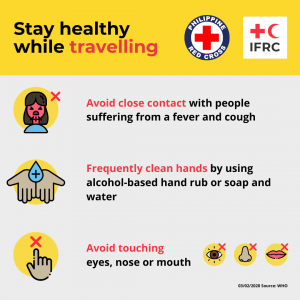
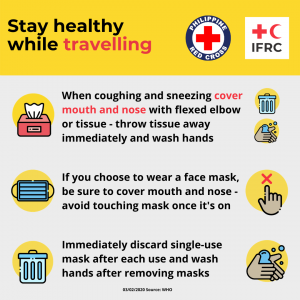
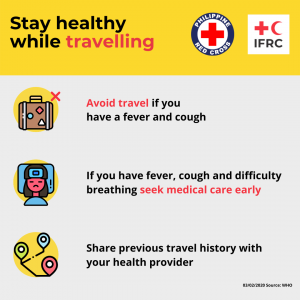
Share this post





